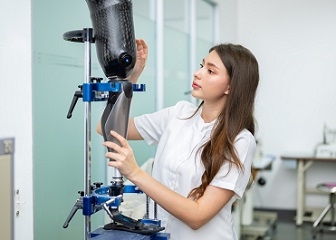Summary
Please enable javascript to play this video.
| Quick Facts: Orthotists and Prosthetists | |
|---|---|
|
$78,100 per year
$37.55 per hour |
|
| Master's degree | |
| None | |
| Internship/residency | |
| 9,500 | |
| 15% (Much faster than average) | |
| 1,500 | |
What Orthotists and Prosthetists Do
Orthotists and prosthetists measure, design, fit, and adapt medical devices, such as supportive braces and artificial limbs, for patients who have disabling conditions.
Work Environment
Orthotists and prosthetists usually work in healthcare settings and in laboratories. Most work full time.
How to Become an Orthotist and Prosthetist
Orthotists and prosthetists typically need to complete a master's degree program and residency to enter the occupation. Some states require these workers to be licensed.
Pay
The median annual wage for orthotists and prosthetists was $78,100 in May 2023.
Job Outlook
Employment of orthotists and prosthetists is projected to grow 15 percent from 2022 to 2032, much faster than the average for all occupations.
About 800 openings for orthotists and prosthetists are projected each year, on average, over the decade. Many of those openings are expected to result from the need to replace workers who transfer to different occupations or exit the labor force, such as to retire.
State & Area Data
Explore resources for employment and wages by state and area for orthotists and prosthetists.
Similar Occupations
Compare the job duties, education, job growth, and pay of orthotists and prosthetists with similar occupations.
More Information, Including Links to O*NET
Learn more about orthotists and prosthetists by visiting additional resources, including O*NET, a source on key characteristics of workers and occupations.
 United States Department of Labor
United States Department of Labor







